Getting to Know Plants Class 3 Questions and Answers Solutions
EVS Class 3 Chapter 4 Getting to Know Plants Question Answer
Write (Page 49)
Question 1.
Write the names of trees that you can recognise. Try to remember where you have seen these trees. Which of these trees have you seen near your home or on your way to school?
Answer:
- I can recognise Banyan, Peepal, Guava, Coconut, Neem and Banana tree.
- I have seen Peepal and Guava tree near my home and Banyan, Guava and Banana tree on the way to school.
Write (Page 50)
Question 1.
Write the names of some shrubs. Have you seen any of the shrubs shown in the pictures above?
Answer:
Rose, tulsi, curry leaf, hibiscus and sunflower are shrubs.
Yes, I have seen shrubs of green gram.
![]()
Question 2.
Do you know what they are called in your mother tongue?
Answer:
In my mother tongue (Hindi) the green gram is known as moong, black gram as urad, red lentils as masoor and pigeon peas as arhar.
Write (Page 52)
Question 1.
Write the names of some herbs that you have seen and where you have seen them.
Answer:
I have seen mint, coriander, mustard and spinach herbs at home.
Guess (Page 54)
Question 1.
Is this a creeper or a climber?

Answer:
Climber.
Question 2.
What do you call it in your language?
Answer:
I call snake gourd in my language Hindi ‘Chichinda’.
Write (Page 54)
Question 1.
Write the names of some climbers or creepers that you have seen and where you have seen them. Are any of them in the pictures given on page 53? What are they called in your language?
Answer:
I have seen money plant, bottle gourd, pumpkin, sweet peas and cucumber. I have seen them in kitchen garden of my mama’s house.
Yes, money plant, bottle gourd and pumpkin are in the pictures. Bottle gourd is called as ‘Lauki’ and pumpkin as ‘Kaddu’ in my language.
Question 2.
Name these plants in your language. Say if they are a tree, shrub, climber or creeper.

Answer:

Activity-1 (Page 54)
Stand, in groups of two to four, next to any tree or shrub that is in or near your school.
Answer:
Do yourself.
Now look around, as far as you can see. Remember to look down near your feet as well!
Answer:
Do yourself.
![]()
How many kinds of trees, shrubs, herbs, grasses, climbers or creepers can you spot?
Answer:
Do yourself.
Activity-2 (Page 55)
Make friends with a Plant!
Choose one plant, preferably a shrub with a thick stem or a tree that you want to make friends with. You can do this by yourself or with a group of your classmates.
Name your plant, just like you might name a pet. Take care of the plant by watering it each day. Also, protect it as your friend.
Now observe your plant friend closely. Here are a few things to observe – its leaves, flowers and fruits. Are there many, a few or no leaves, flowers and fruits? Record your observations in the table on the next page.
Time and date of observation: ___________________________
Month: ___________________________________________________
Weather on the day you are recording this information: ____________________________________________
Visit your plant friend as often as you can and observe it carefully.

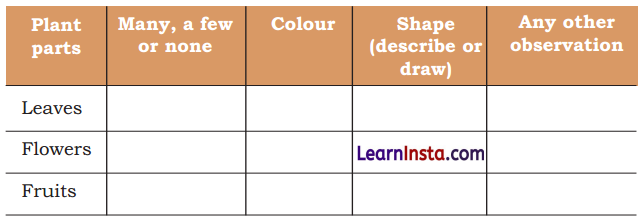
Answer:
Time and date of observation: 7’o clock in morning/6-7-2024
Month: July
Weather on the day you are recording this information: Cloudy
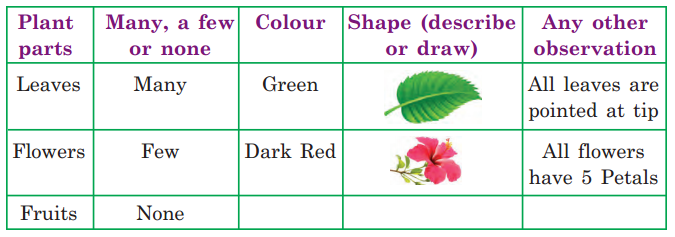
Activity-3 (Page 56)
Question 1.
Do you find new leaves growing on the plant? Do the colours of the leaves change as they grow larger?
Answer:
Yes, I find new leaves growing on the plant.
Yes, the colour of the leaves changes from light green to dark brown as they grow larger.
Question 2.
Do the old brown leaves fall to the ground?
Answer:
Yes, the old brown leaves fall to the ground.
Question 3.
Do you find flowers appearing or notice any fruit?
Answer:
I find only flowers not any fruit.
Question 4.
What are other observations you have? Note down your observations.
Answer:
I observe the plant has many leaves, flowers but not fruits. The flower is very attractive and of bright red colour. The flower has a tube like structure inside it.
Write (Page 56)
Question 1.
Write about your plant in your notebook.
Answer:
- I have closed hibiscus plant. It is a shrub. It has many dark green colour leaves. It has many attractive flowers. Flowers have pleasant smell.
- Hibiscus flowers have short life-span. They bloom in the morning and wilt by the evening of same or next day.
- The leaves of the plant are heart shaped which are pointed at the tip.
- In my mother tongue the plant is known as Gurhal.
Activity-4 (Page 57)
Question 1.
- Observe the leaves in your surroundings.
- Draw, colour and label them in your notebook.
- Describe their colour, shape, size, texture and smell to your friend in the class.
- What statements can we make about leaves after doing this activity?
Answer:
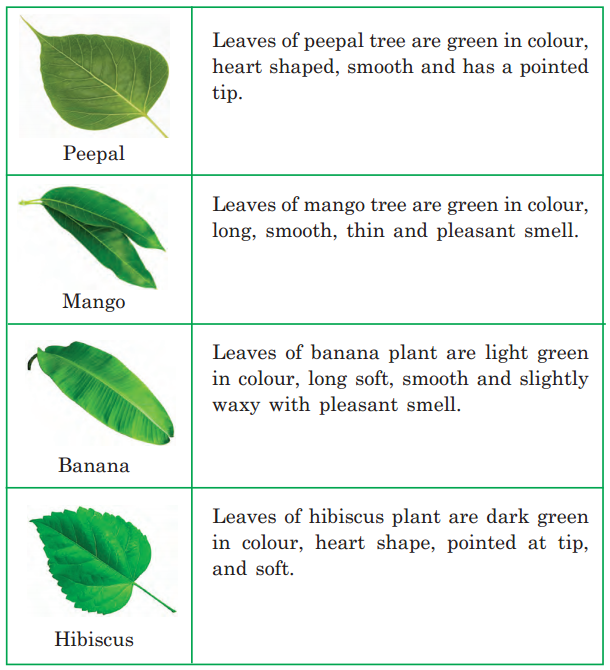
Activity-5 (Page 57)
Blindfold yourself while your friend gradually brings a fruit close to you. From how far can you recognise the fruit with your eyes closed? Now repeat the same experiment with pieces of cut fruit. Was it easier to recognise cut fruit by the smell rather than the whole (uncut) fruit? Which fruit could you smell from farthest away? Try this experiment at home too.
Answer:
Do yourself.
![]()
Parts of a Plant (Page 58)
Question 1.
What are the parts of a plant?
Answer:
Roots, stems, leaves, flowers, fruits and seeds are the parts of a plant.
Question 2.
Mark different parts of the plant and label them.
Answer:
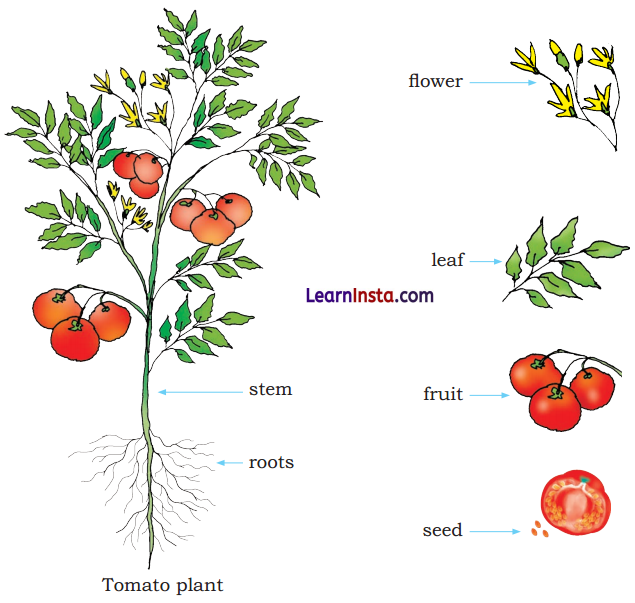
Activity-6 (Page 59)
Question 1.
Did you notice any other animals, birds and insects on the plant?
Answer:
I noticed some insects on the plant.
Question 2.
What were they doing?
Answer:
They are moving on tree trunk here and there.
Let us Reflect (Page 60)
A. Discuss
Question 1.
What would happen if there were no plants?
Answer:
We would not get any food if there were no plants.
Question 2.
How does the root help a plant to grow?
Answer:
The roots help the plant to fix in the soil and absorb water and minerals from the soil.
Question 3.
What is the role of the stem?
Answer:
Stem bears different parts of plants such as leaves, fruits, and flowers. It helps in the transport of food and water in different parts of plants.
B. Write
Question 1.
List the names of plants that you have seen in your school, park or near your home. Identify what types of plants they are — tree, shrub, herb, grass, climber, or creeper.
Answer:
| Name of Plant | Types |
| Banyan | Tree |
| Neem | Tree |
| Peepal | Tree |
| Rose | Shrub |
| Tulsi | Shrub |
| Bottle Gourd | Climber |
| Mango | Tree |
| Money Plant | Climber |
| Pumpkin | Creeper |
| Wheat | Grass |
| Mint | Herb |
| Spinach | Herb |
Question 2.
Which particular part of the plant helped you to identify the type of the plant?
Answer:
Stem
![]()
Question 3.
Describe your favourite plant. Why is it your favourite?
Answer:
My favourite plant is Rose. It is a shrub. It is a beautiful flowering plant with thorny stems. It is my favourite because rose flowers are of different colours and have very sweet fragrant.
C. Draw
Draw different types of leaves you have seen around you.

Answer:
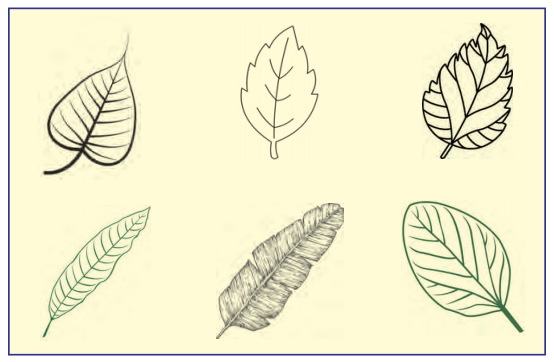
D. Make a Rangoli
Collect leaves and flowers fallen on the ground. Arrange them in patterns to make a rangoli. You may also create different animal shapes using the collected leaves.
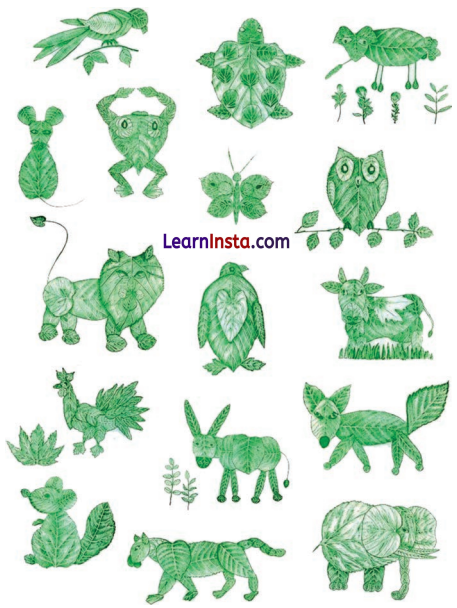
Answer:
Do yourself.